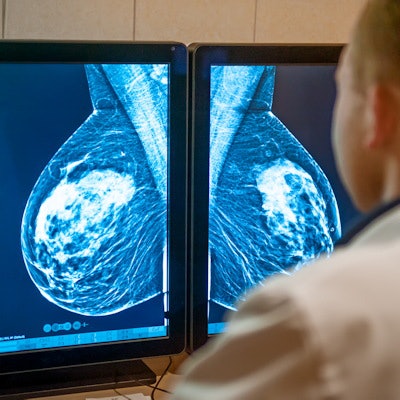
Breast cancers that are detected in the interval between national screening program mammograms have a worse prognosis than those detected at the time of a screening, even if they have the same biology, researchers from the Netherlands reported at the 12th European Breast Cancer Conference (EBCC12) on 3 October.
Dr. Josephine Lopes Cardozo, a PhD candidate at the Netherlands Cancer Institute (NKI) in Amsterdam and medical fellow at the European Organization for Research and Treatment of Cancer (EORTC) in Brussels, told delegates online that the method of detection can give additional prognostic information and should be taken into account when deciding on what treatments in addition to surgery might be needed.
 Dr. Josephine Lopes Cardozo.
Dr. Josephine Lopes Cardozo.Analysis of results from over eight years' follow-up of the international MINDACT randomized phase III clinical trial shows that although tumors may have the same genetic make-up, the way they are detected makes a significant difference to the period of time before the disease starts spreading to other parts of the body or results in death, whichever comes first. This is known as the distant metastasis-free interval (DMFI), she explained.
Lopes Cardozo and her colleagues had found previously that tumors that interval cancers were more likely to have a high-risk genetic profile, as shown by a test that looks at the activity of 70 genes in the tumor tissue (the 70-gene signature, commercially known as MammaPrint), and were therefore at higher risk of distant metastases.
"However, there are also screen-detected cancers with a high-risk 70-gene signature," she said in an EORTC statement. "In our current analysis, we found a significant difference in survival between high-risk cancers detected during screening or in the interval between screenings. The eight-year DMFI rate was higher among women with screen-detected cancers than for women with interval cancers: 93.8% versus 85.2%."
Although these tumors have the same biology -- all 70-gene, high-risk and with similar tumor characteristics -- they have different prognoses based on their method of detection, she continued. This suggests that the method of detection is an additional prognostic factor in this group of patients.
"The method of detection combined with the 70-gene signature can further optimize treatment for patients at high risk of recurrence. For patients with a very low risk of recurrence, longer follow-up may also help to identify those who are currently at risk of being overtreated," Lopes Cardozo noted.
Study details
The study included a total of 1,102 Dutch breast cancer patients enrolled in the Microarray in Node-negative Disease may Avoid Chemotherapy (MINDACT) trial between 2007 and 2011. The patients all participated in the national screening program and were ages 50-75. The Dutch national screening program invites women ages 50-75 for screening every two years.
The researchers evaluated differences in DMFI for high, low, and ultralow risk tumors, as classified by the 70-gene signature. A total of 754 cases were detected during screening, and 348 were identified during the interval between screenings.
With 50% of patients having reached at least 8.6 years of follow-up, there were 83 occurrences of distant metastases or death due to breast cancer. Among patients with screen-detected cancers, 36% received no adjuvant systemic treatment (such as chemotherapy and hormone therapy, in addition to surgery and radiotherapy), 33% received hormone therapy only, and 30% received chemotherapy with or without hormone therapy. Among patients with interval cancers, 17% received no adjuvant systemic treatment, 35% had hormone therapy only, and 47% had chemotherapy with or without hormone therapy.
"Most patients who received no adjuvant systemic therapy had grade I tumors, smaller than 2 cms, had no signs of cancer in their lymph nodes and were classified as ultralow or low risk by the 70-gene signature," said Lopes Cardozo.
When the researchers looked at survival rates at eight years, they found that patients with screen-detected cancers had an eight-year DMFI rate of 98.2% in 118 women with ultralow-risk tumors, 94.6% in the 398 women with low-risk tumors, and 93.8% in the 238 women with high-risk tumors.
Patients with interval cancers had an eight-year DMFI rate of 97.4% in the 39 women with ultralow-risk tumors, 92.2% in the 143 women with low-risk tumors, and 85.2% in the 166 women with high-risk tumors.
Among patients with high-risk tumors, those that were detected in the interval between screenings had a 2.4-fold increased chance of developing distant metastases compared with those whose cancer was detected during screening.
"Both screen-detected and interval breast cancers have very good eight-year distant metastasis-free interval rates. However, among patients with high-risk tumors as classified by the 70-gene signature, there is a significant difference in these rates between screen-detected and interval cancers," she noted. "Combining the prognostic information provided by the 70-gene signature and the method of detection can help to choose the best treatment for these patients."
Expert view
"This study highlights an interesting difference between breast cancers that are detected at the time a woman attends a scheduled appointment as part of a national screening program (screen detected) and those that are diagnosed in the interval between screenings (interval cancers)," said Prof. David Cameron, from the University of Edinburgh Cancer Centre, U.K., in the EORTC statement.
It has been previously noted that interval cancers are more likely to be high grade and that would be associated with a poorer outcome, but the novel finding here is that for those cancers identified biologically as being high risk by the 70-gene signature test, the screen detected ones do better than those presenting as interval cancers, according to Cameron, who represents the European Breast Cancer Council at EBCC12 and was not involved with the research.
If these results are confirmed in another series, it would suggest that earlier diagnosis via screening of more biologically aggressive cancers is worthwhile: screen-detecting such cancers may improve patients' survival, Cameron noted.
"The findings also suggest that clinicians should take into account the method of detection as an additional prognostic factor when considering adjuvant therapy, enabling further personalization of therapy to the individual woman and her cancer. This is as important for low-risk cancers as for high-risk ones," he pointed out.
Longer follow-up for low-risk cancers could give us more information as to whether more aggressive treatments could be avoided, as these tumors can recur 15 to 20 years later, he concluded.



















